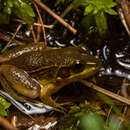en
names in breadcrumbs


Not much information is available on Lithobates okaloosae, because it is limited to one small geographic location, and it is very rare. "Our knowledge of this species is currently limited to distribution, seasonality, and some aspects of larval life history" (Moler, 1992).
Males of this species call to females during the breeding seasone with a series of gutteral "chucks," which they repeat at about 5 notes/sec, slowing audibly at the end. There is variation in the number of notes per call, and in intervals between cals depending on conditions. The frogs also issue single quieter notes, in response to calls coming from other nearby males.
Rana okaloosae's call is similar to Rana virgatipes.
Communication Channels: acoustic
Perception Channels: visual ; tactile ; acoustic ; chemical
In "Rare and Endangered Biota of Florida," Moler describes Lithobates okaloosae as rare. This species was discovered in 1982 by Paul Moler, and has been located at only 23 sites, associated with small, cool, clear seepage streams. Three of these localities are based only on single specimens, so these sites probably don't support viable populations.
Residential developments in the areas where the frog lives convert streams into chains of lakes (through a series of dams). This poses a threat to Florida's Bog Frog habitats. So, it is important that the streams where the frogs live are protected (this can be done through the management of streamside vegetation).
US Federal List: no special status
CITES: no special status
IUCN Red List of Threatened Species: vulnerable
Not much is known about the development of Lithobates okaloosae. In general eggs are laid near the surface of the water in thin gelatinous masses. The tadpoles overwinter, and they metamorphose during the following spring or summer. The adults remain year long in the areas used as breeding habitats.
Development - Life Cycle: metamorphosis
We have no information on the food habits of this species. However, it probably feeds like other species of it's genus (Rana). In this case, then adults would be predators on small animals, mostly invertebrates like insects and spider, possibly very small vertebrates, such as other tiny frogs.
If the larvae feed like other members of the genus, then they are grazing on algae, feeding on detritus, and possibly consuming some small zooplankton.
Animal Foods: amphibians; insects; terrestrial non-insect arthropods; zooplankton
Plant Foods: algae
Other Foods: detritus
Primary Diet: carnivore (Insectivore ); detritivore
This is very rare species of frog. Lithobates okaloosae is found in only a small area of western Florida (Okaloosa, Santa Rosa, and Walton counties). It is "associated with small tributary streams of East Bay, Shoal, and Yellow rivers."
Biogeographic Regions: nearctic (Native )
This species lives in or near shallow, nonstagnant seeps with somewhat acidic water (pH 4.1-5.5). It's also found along shallow, boggy overflows of larger seepage streams. It is often associated with black titi and Atlantic white cedar.
Habitat Regions: temperate ; terrestrial ; freshwater
Terrestrial Biomes: forest
Aquatic Biomes: rivers and streams
Wetlands: bog
Other Habitat Features: riparian
We have no information on how long these frogs live.
Males are 34.8-45.8 mm long, and females are 38.2-48.8 mm long. "The species is characterized by an unspotted dorsum, distinct dorsolateral folds that do not reach the groin, and reduced webbing of the foot". The reduced webbing distinguishes Lithobates okaloosae from all other American congeners.
"At least three phalanges of the 4th toe are free of webbing and at least two phalanges of all other toes are free".
Lithobates okaloosae has a dark green or green-brown back, a black belly and a yellow throat. It can have lighter spots on the lower jaw.
Lithobates okaloosae tadpoles have an olive brown coloration and have buff spots on the tail. The tadpoles' ventral surfaces are marked with white spots.
Range length: 34.8 to 48.8 mm.
Other Physical Features: ectothermic ; heterothermic ; bilateral symmetry
Sexual Dimorphism: female larger
Adults and tadpoles have patterns of skin coloration that are cryptic, making them less visible to predators. As with most frogs, adults will jump away from predators and hide in the water if they can. We have no information on which predators attack this species.
Anti-predator Adaptations: cryptic
Males call through a "series of 3-21 gutteral chucks repeated at about five notes per second, but slowing audibly at the end." (Moler, 1992). The frog's calls are heard from mid-April to mid-September. We have no information on the number or pattern of matings in this species. In other species in the genus Rana, males attempt to fertilize the eggs of multiple females. Females may also exercise choice, and allow several males to fertilize their eggs.
Mating System: polygynandrous (promiscuous)
They deposit several hundred black eggs as a surface film (in thin gelatineous masses). Lithobates okaloosae tadpoles overwinter and metamorphose the next spring or summer.
Breeding season: Late spring through summer.
Key Reproductive Features: iteroparous ; seasonal breeding ; gonochoric/gonochoristic/dioecious (sexes separate); sexual ; fertilization (External ); oviparous
There is no parental care in this species.
Parental Investment: no parental involvement